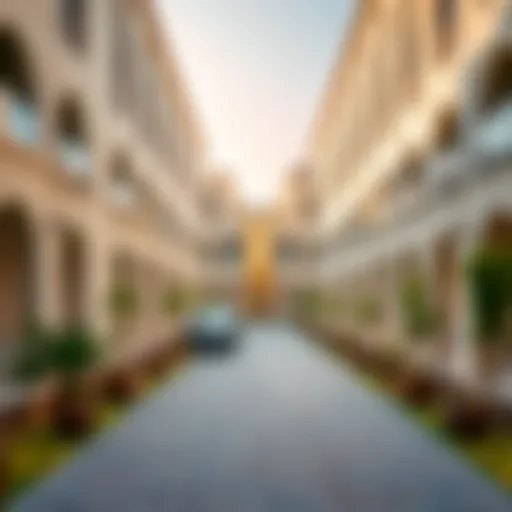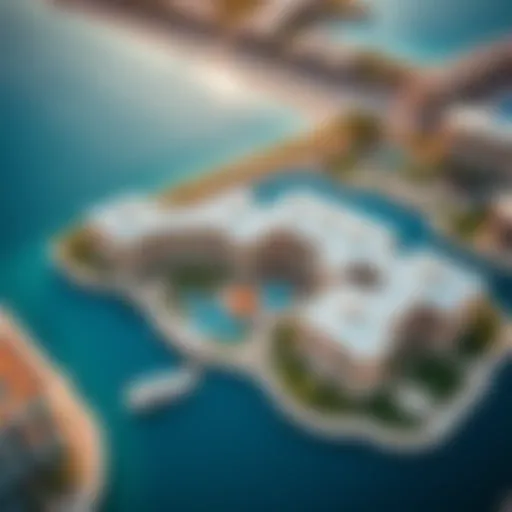Building a Sustainable Future in Dubai's Green Communities
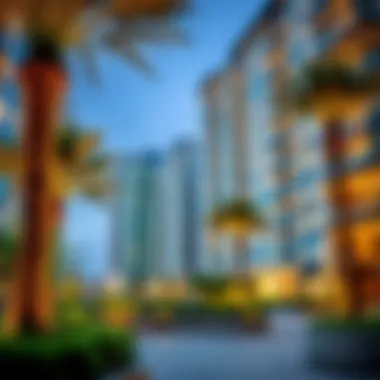

Intro
Dubai is not just a city of soaring skyscrapers and luxury malls; it's evolving into a place where sustainability takes center stage. This transition is captured in the rise of green communities, a significant thread in the fabric of urban development.
As urbanization sweeps across the globe, cities like Dubai are looking beyond traditional growth. They are millking ideas of environmental sustainability, integrating eco-friendly practices into their neighborhoods. This article sheds light on the green community movement in Dubai, emphasizing the principles that guide it—principles that combine ecological health with urban living.
The ongoing transformations shape not only the skyline but also the way residents may live their lives in these neighborhoods, fostering a collaborative spirit among community members. By examining real examples and future predictions, we delve into how these initiatives enhance not just ecology, but the very quality of life for those who call Dubai home.
From nurturing urban biodiversity to employing energy-efficient practices, the green movement isn't just a trend; it’s a shift towards a sustainable future. As we explore the impact of such communities, we aim to provide investors, homebuyers, and anyone interested in the dynamics of future living in this vibrant city with a comprehensive understanding of what’s at stake and what’s ahead.
Defining Green Community
In the context of urban development, the term "green community" encapsulates more than just eco-friendly living; it embodies a holistic approach to integrating sustainable practices into everyday life. Understanding this concept is crucial, especially in a rapidly developing metropolis like Dubai, where the landscape is ever changing, and the need for environmentally conscious living is becoming more urgent. Green communities aim to create a balance between the built environment and nature, enhancing the quality of life for residents while addressing environmental concerns.
Green communities are tailored to foster a sense of belonging among residents. This is crucial for engaging people in sustainable practices, creating spaces that encourage local interactions and a shared sense of responsibility towards the environment. By prioritizing energy-efficient designs, green spaces, and sustainable resource management, these communities not only plan for today but lay a foundation for a resilient future.
Origins of the Green Community Concept
The concept of green communities can trace its roots back to earlier movements advocating for environmentally friendly living. Although the term may feel contemporary, its foundations can be found in the principles of sustainability and consciousness regarding environmental degradation that gained traction in the late 20th century. Communities began experimenting with different models of land usage, emphasizing green spaces and ecological balance.
In places like Europe and North America, the initial spark for these ideals often originated from grassroots activism. Residents sought to reclaim urban spaces, turning neglected areas into green belts. This principle has migrated across continents, adapting to local needs and regulations. In Dubai, these notions have been shaped further by governmental support and investment, dictating a more structured development of sustainable communities.
Key Characteristics
Green communities possess several defining features that set them apart from traditional urban settings. Here are some of the key characteristics to note:
- Sustainable Design: Buildings and infrastructure employ eco-friendly materials and energy-efficient technologies, reducing their carbon footprint.
- Green Spaces: Parks, gardens, and natural reserves are integral parts, enhancing biodiversity and providing recreational opportunities for families.
- Water Management: Effective strategies for water conservation, such as rainwater harvesting and wastewater recycling, are routinely implemented to ensure sustainability.
- Community Engagement: These communities often have programs promoting resident involvement in sustainability initiatives, fostering stronger social ties and a collective responsibility toward the environment.
- Alternative Transport Options: Emphasis is laid on pedestrian-friendly pathways, bicycle lanes, and access to public transport, reducing the reliance on cars.
In summary, defining a green community extends beyond mere ecological considerations. It intertwines elements of cultural identity, economic viability, and social connectivity, creating spaces that not only support a sustainable lifestyle but enrich community life as well. As Dubai continues to grow, understanding these foundational aspects will be crucial for investors, realtors, renters, and homebuyers looking to engage with the green community movement.
"Green communities are not just about trees and buildings; they're about shifting mindsets and anchoring a culture of sustainability."
For more information on this crucial movement, you can visit resources from Wikipedia, Britannica, and local community initiatives on Facebook.
The Relevance of Green Communities in Urban Spaces
In the hustle and bustle of modern cities, where concrete towers often overshadow greenery, the relevance of green communities shines brighter than ever. These spaces serve not just as residences but as holistic ecosystems that tackle urban challenges while enhancing the quality of life for residents. The underlying concepts of green communities resonate with sustainability, community engagement, and ecological health. This movement in Dubai, with its rapid urbanization, shows how intertwined prosperity and environmental stewardship can be.
Addressing Urbanization Challenges
Urbanization brings a plethora of challenges, from increased pollution levels to traffic snarls and heat islands. In Dubai, where rapid development seems endless, green communities offer a breath of fresh air—quite literally. They incorporate biophilic design, which fosters connections with nature. Such designs blend parks, gardens, and green roofs into urban architecture, mitigating the suffocating nature of cityscapes.
One significant advantage of these communities is their ability to filter airborne pollutants. Plants breathe life into the urban environment, absorbing carbon dioxide and releasing oxygen, which enhances air quality. Moreover, they provide shaded areas that can diminish the urban heat effect. As such, green spaces are more than just pretty sights—they actively combat the adverse environmental impacts caused by urban sprawl.
The following are pivotal ways green communities address urbanization challenges:
- Enhanced Air Quality: Natural vegetation purifies air, ensuring residents breathe cleaner air.
- Urban Heat Reduction: Greenery mitigates the heat absorbed by pavements and buildings, creating a cooler microclimate.
- Biodiversity Protection: Preserving native species fosters ecological balance, enhancing urban biodiversity.
Promoting Sustainable Living
Green communities don’t merely advocate for sustainability; they practice it in their daily operations. By promoting a lifestyle that minimizes resource consumption, they are equipped to handle the exigencies of today while safeguarding the environment for future generations. The ethos of sustainable living permeates various facets of life within these communities, including energy consumption, waste management, and community interaction.
Energy efficiency takes center stage, with many developments opting for renewable energy solutions like solar panels. These innovations not only lower monthly bills but also reduce reliance on fossil fuels.
In terms of waste management, residents learn to recycle, compost, and reduce waste, fostering a culture of mindfulness about consumption. Such habits are invaluable in an age where the throwaway society is increasingly problematic.
Community interaction is also paramount in green communities. When residents take part in local initiatives, whether it’s a composting workshop or a tree-planting day, they develop a stronger bond with their neighbors and a sense of ownership towards their local environment. This sense of community often leads to increased advocacy for sustainable practices, creating a ripple effect that transcends individual households.
Green communities are essential in shaping a sustainable city landscape. They represent not just a trend but a necessary shift toward smarter urban design that respects both nature and the needs of its inhabitants. By fostering a collaborative approach towards sustainability, these communities contribute to making Dubai not just a city for today, but for the future.
"In a world where urban sprawl seems unstoppable, the notion of green communities offers a lifeline, demonstrating that ecological balance and urban living can coexist harmoniously."
To delve further into the relevance of green communities, resources such as Wikipedia, Britannica and various environmental forums on Reddit can provide a more profound understanding and additional insights.
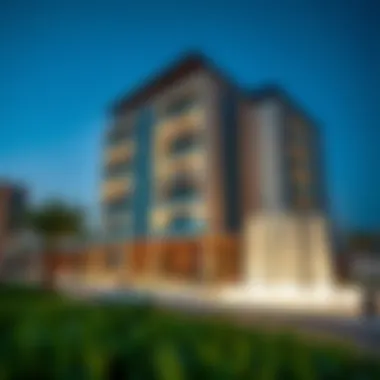

Environmental Benefits
The concept of green communities goes hand-in-hand with numerous environmental advantages that are critical in today’s urban context. These benefits reflect a holistic approach towards integrating natural systems within built environments. Understanding these can empower investors, realtors, renters, expats, and homebuyers alike to appreciate the impact of sustainable practices in modern living environments.
Reducing Carbon Footprint
One of the most pressing concerns of urban areas is their contribution to greenhouse gas emissions. Green communities take significant steps to mitigate their carbon footprint. By focusing on renewable energy sources—like solar panels and wind energy—these neighborhoods greatly reduce reliance on fossil fuels. In Dubai, there’s an increasing spotlight on initiatives that promote energy efficiency, such as smart home technologies that optimize energy usage without sacrificing comfort.
According to studies, transitioning to green community designs could lead to a reduction in carbon emissions by as much as 30% compared to traditional urban developments.
Moreover, the incorporation of green spaces acts as a natural carbon sink, absorbing carbon dioxide and releasing oxygen. Investing in parks and gardens, as seen in many of Dubai's new projects, not only enhances aesthetic appeal but also plays a vital role in cleaning the air. Homebuyers are often attracted to such environments, knowing they contribute to healthier lifestyles and a more sustainable future.
Enhancing Urban Biodiversity
Biodiversity in urban settings is often underestimated. Amidst the hustle and bustle of city life, creating habitats for various species leads to ecological richness. Green communities prioritize landscaping that includes native plants, trees, and vegetation that is suited to the local climate. This approach encourages the growth of flora and fauna that, in turn, supports pollinators like bees and butterflies, which are crucial for our ecosystems.
Moreover, community gardens not only serve as a source of fresh produce but also foster local wildlife. The presence of such green enclaves can create a microhabitat, helping species thrive even within densely populated areas like Dubai.
In embracing these green solutions, residents can promote a healthier interaction with nature, showcase ecological stewardship, and make urban areas more hospitable for a variety of life forms.
Water Conservation Strategies
Water conservation is a major element within the framework of sustainable living, particularly in arid regions such as Dubai. The implementation of innovative strategies for water use is imperative given the environmental challenges posed by climate change. Green communities foster practices that significantly lower water consumption.
For instance, rainwater harvesting systems and smart irrigation techniques are commonly integrated into the infrastructure of these communities. This not only reduces dependency on the municipal water supply but also decreases wastage. Additionally, xeriscaping—landscaping that reduces or eliminates the need for irrigation—has gained traction in many residential designs. By utilizing drought-resistant plants, these communities can minimize water use while maintaining attractiveness.
Homebuyers who prioritize sustainability are increasingly aware of the long-term cost benefits of water-efficient homes. Coupled with the broader environmental impact of responsible water management, these strategies align with the goals of individuals looking to invest in a greener future.
Economic Implications of Green Living
The concept of green living transcends beyond ecological benefits; it also plays a vital role in the economy, particularly within the context of Dubai's urban landscape. As society turns towards sustainable practices, understanding the economic implications of green initiatives becomes critical for investors, homeowners, government bodies, and entire communities. Embracing green community concepts not only facilitates environmental preservation but also promotes financial viability. Here, we break down how incorporating sustainability into urban planning can yield substantial economic benefits.
Cost-Effectiveness of Sustainable Practices
When it comes to sustainable living, initial investments often stir anxiety among potential stakeholders. However, the long-term savings associated with sustainable practices are generally overlooked. Consider renewable energy systems, like solar panels. While the upfront cost may seem hefty, they quickly pay for themselves through reduced utility bills and various governmental rebates.
Moreover, energy-efficient buildings often consume less energy, which translates into significant savings over time. Below are some examples:
- Energy Bills: Properties designed with sustainable materials and technologies frequently witness a considerable drop in energy use. This results in lower bills, contributing to higher disposable income for residents.
- Maintenance Costs: Sustainable structures often require less upkeep due to the durability of green building materials, allowing more funds to be allocated toward other important facets of life.
- Resilience Against Price Fluctuations: Operating costs linked to fossil fuels are notoriously volatile. Green practices shield investors and homeowners from unexpected price spikes related to traditional energy sources.
"Investing in sustainable practices is not just about immediate costs; it's about shaping an economically sound future."
Impact on Property Values
As the global shift towards sustainability continues, properties located in eco-friendly communities are becoming increasingly desirable. This trend is especially prevalent in Dubai, where the luxury and comfort of living is paralleled with the hype of environmentally-conscious choices.
- Increased Demand: Real estate driven by sustainable practices often sees greater demand due to public interest in green living. Buyers, particularly expats and families, prefer homes that align with their values towards sustainability.
- Higher Resale Value: Homes within green communities frequently command higher market prices due to the perceived value added by energy efficiency and community amenities. When the time comes to sell, owners often find they can ask for a premium.
- Attracting Tenants: For property owners, renting in green communities can also lead to a steady influx of tenants. An increasing number of renters are focusing on sustainable living options, which can result in lower vacancy rates. This is particularly important in metropolitan areas like Dubai, where renters prioritize modernity and eco-friendliness.
Social Dimensions of Green Communities
The significance of social dimensions within green communities cannot be overstated. As urban environments grapple with the realities of population growth and environmental degradation, the social fabric of communities emerges as a vital component. In the context of Dubai, a city known for its astonishing architecture and rapid development, the social elements woven into green communities foster not only a sense of belonging but also catalyze sustainable living practices. This fusion of community and sustainability stands to benefit residents on multiple fronts, establishing a holistic approach to modern urban living.
Creating Interactive Spaces
Interactive spaces within green communities serve as essential venues that encourage social interaction and collaboration among residents. These spaces can take various forms, including parks, community gardens, and multi-use facilities designed for recreation and education. The fundamental purpose of such spaces is to break down the barriers often created by urban lifestyles and foster connections.
For instance, parks equipped with walking paths, fitness stations, and seating areas invite residents to partake in physical activities while mingling with neighbors. Community gardens not only provide fresh produce but also offer opportunities for residents to engage in sustainable practices together. The designs of these interactive spaces aim to create environments where interactions happen organically.
Here are some benefits of creating interactive spaces:
- Encouragement of Physical Activity: Well-designed parks and recreational areas promote healthy living.
- Social Cohesion: Shared spaces help bridge cultural and demographic divides, cultivating friendships.
- Environmental Awareness: Interactive areas often feature educational components about sustainability, helping residents learn together.
Fostering a Sense of Community
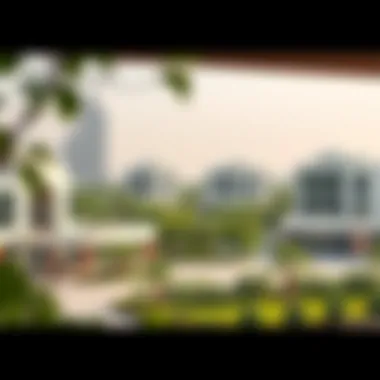

Fostering a sense of community in green neighborhoods goes beyond mere physical proximity; it is about nurturing relationships and creating a culture of collaboration and mutual support. In Dubai’s context, where the expatriate population is significant, the challenge often lies in uniting diverse groups under a common identity rooted in sustainability.
Several strategies can be employed to foster this sense of community:
- Community Events: Organizing regular events such as farmers' markets, workshops, and cultural festivals can engage residents and build ties among them.
- Participatory Decision-Making: Involving residents in discussions about community projects encourages ownership and accountability, making them feel valued.
- Volunteer Programs: Building volunteer-driven initiatives around environmental projects can unite residents with shared goals, reinforcing their commitment to the community.
Creating an inclusive model where everyone feels welcome and essential not only enhances the quality of life but also strengthens communal ties. It cultivates an environment where individuals are driven to contribute to both the community and the planet in meaningful ways.
By investing in both interactive spaces and community bonding, Dubai’s green communities can become exemplary models of sustainable living while addressing social needs.
Overall, the social dimensions of green communities in Dubai create networks that enhance not just living conditions but also cultivate a collective ethos of respect for both people and the planet.
Case Studies of Green Communities in Dubai
Examining specific case studies of green communities in Dubai sheds light on successful practices and models that contribute to sustainable urban living. These examples serve as a blueprint for future developments, showcasing how innovative design, community initiatives, and strong regulatory support can harmonize with environmental conservation. Let's delve into some significant case studies that illustrate the best of what green communities can offer in a bustling metropolis like Dubai.
Prominent Developments
In Dubai, certain developments stand out as pioneers in the green community movement, blending sustainability with modern living. Notable among them is Sustainable City, a community designed from the ground up with an emphasis on eco-friendly practices. This development features energy-efficient housing, solar panels, and electric vehicle charging stations throughout. The planners considered not just architectural aesthetics but also how to create spaces that encourage a low-carbon lifestyle.
Another remarkable example is Dubai Hills Estate. While primarily known for its luxury offerings, it integrates green spaces seamlessly, including parks and walking trails that foster community interaction. The design prioritizes water conservation through the use of reclaimed water for landscaping and irrigation. These projects highlight the importance of thoughtful planning in establishing green communities that balance luxury and sustainable practices.
Innovative Design Approaches
The architectural approaches within these green developments often break the mold. The Sustainable City, as mentioned, employs a design philosophy that maximizes natural light while minimizing energy usage. Buildings are oriented to optimize natural ventilation, and materials used are sourced sustainably, reducing the carbon footprint significantly. The living environment promotes not only comfort but also ecological responsibility.
Masdar City, albeit not within Dubai’s city limits but a crucial part of the UAE’s green vision, takes innovation further. It is designed to be one of the most sustainable urban developments worldwide, with unique features such as a zero-carbon footprint and reliance on renewable energy sources. The city integrates cutting-edge technologies like smart grids to manage energy consumption efficiently. These innovative approaches are essential for fostering a sustainable future.
Community Initiatives
Community initiatives are the lifeblood of the green community concept. They facilitate the engagement of residents in sustainability efforts. In Sustainable City, for example, residents participate in educational programs focusing on renewable energy, sustainable farming, and waste management. This hands-on approach helps inculcate a sense of responsibility and connection to the environment.
In tandem, community gardens and workshops provide platforms where residents can share knowledge about sustainable practices, such as urban gardening or composting. Emphasizing community-driven initiatives not only promotes ecological awareness but also fosters social cohesion among residents, feeding into the overall ethos of a green community.
As the saying goes, "Many hands make light work," and in the context of sustainable living, collective effort paves the way for meaningful change.
Ultimately, these case studies underline the significance of combining smart design with active community participation, thus shaping a more sustainable and livable urban environment in Dubai. Investors, realtors, renters, expatriates, and homebuyers alike can look to these examples as guiding lights in the booming real estate landscape of the city.
For more information about innovations in sustainable development, you can visit Masdar or explore the planning visions presented by the Dubai Municipality.
These case studies not only highlight what has been done but encourage further exploration and potential investment in similar initiatives that could bolster green living in urban areas.
Government Policies Supporting Green Initiatives
The role of government policies in promoting green initiatives cannot be overstated. In Dubai, where rapid urbanization meets ambitious sustainability goals, these policies are more than just regulations; they serve as a framework for fostering innovative practices that align environmental health with economic growth. Understanding this relationship is crucial for all stakeholders in the community—investors, realtors, renters, expats, and homebuyers alike.
Government initiatives not only delineate guidelines but also emphasize the commitment to creating a sustainable urban landscape. Through comprehensive policies, Dubai aims to transform its communities while enhancing the quality of life for its residents. The following sections will take a closer look at two vital components of these policies: regulatory frameworks and funding incentives.
Regulatory Frameworks
The regulatory frameworks in place aim to create a conducive environment for the development of green communities. These frameworks consist of various comprehensive policies and regulations that guide urban planning, construction practices, and community development efforts. For instance, the Dubai Green Building Regulations help to ensure that new buildings meet essential sustainability criteria.
These regulations require developers to incorporate energy-efficient systems and renewable energy sources, which ultimately contribute to the reduction of overall energy consumption. The building codes mandate features such as insulation, energy-efficient windows, and advanced HVAC systems, encouraging more sustainable practices.
Moreover, the commitment to transparency and public involvement stands out. The Dubai Municipality has established guidelines that encourage community engagement throughout the planning stages, ensuring that resident inputs are considered, ultimately strengthening communal ties. This regulatory landscape supports a well-rounded approach where economic and environmental objectives intersect.
"A green community is not just about building structures; it’s about fostering a holistic life experience that benefits both residents and the environment."
Funding and Incentives
Financing green initiatives can often be a steep hill to climb. To mitigate these financial challenges, the Dubai government offers a variety of funding and incentives designed to encourage the adoption of sustainable practices. One prominent program is the Dubai Green Fund, which aims to provide financial backing for projects that adhere to green principles. This initiative can lower the barrier to entry for developers and facilitate the integration of sustainable features in the built environment.
In addition to direct funding, there are tax exemptions and grants available for developers who meet specific sustainability standards. This financial encouragement can act as a catalyst for local businesses to invest in energy-efficient technologies and practices, ultimately benefiting the community as a whole. Incentive programs may include reduced fees for building permits, rebates on utilities for energy-efficient installations, and subsidies for renewable energy systems.
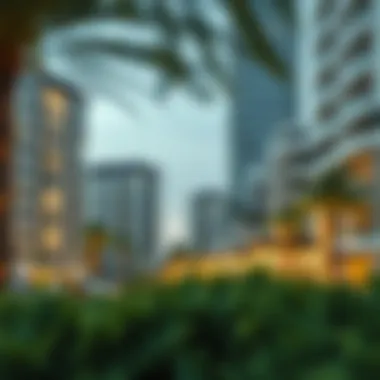

Thus, enhancing financial support makes it easier for all stakeholders to participate in building the green community vision. By creating a tangible path to financial sustainability, these policies empower residents and developers alike to embrace innovative solutions to urban living challenges.
With a well-structured policy environment in place, Dubai is poised to set a benchmark in sustainable urban development, paving the way for greener communities that reflect a profound commitment to environmental stewardship.
Challenges in Implementing Green Community Concepts
The idea of green communities in Dubai offers a captivating vision of sustainability, but it doesn't come without its share of hurdles. This section sheds light on the critical challenges faced when translating the green community concept into action. Understanding these challenges is vital for all stakeholders, from investors to residents, as it shapes the future landscape of urban living.
Overcoming Cultural Barriers
Creating green communities requires more than just building eco-friendly structures. It demands a shift in the mindset of residents and the broader المجتمع. In a city like Dubai, where traditions and modern influences intersect, there can be a tug-of-war between old habits and new ideals. Many individuals might be hesitant to embrace unfamiliar practices such as recycling or conservation, stemming from cultural norms that have been in place for generations.
To foster acceptance, community leaders and planners need to engage residents through cultural education and outreach programs. Hosting workshops and informational sessions can facilitate a deeper understanding of sustainability practices. From collaborating with community influencers to leading sustainability initiatives, local groups can play an essential role in bridging the cultural divide.
As people start to see the tangible benefits of greener lifestyles—like improved health and reduced utility costs—they may begin to shift their perspectives. One encouraging community project in Dubai is the introduction of community gardens, where residents come together to grow food, thus promoting sustainability while nurturing social bonds.
Financial Constraints
While the heart may be set on green living, the wallet sometimes says otherwise. Financial constraints are often cited as a roadblock in the development of green communities. Despite the long-term savings associated with sustainable practices, the upfront costs can be daunting. Investors and developers may find themselves wrestling with the temptation to cut corners or utilize cheaper, less sustainable materials to stay within budget.
To paint a brighter financial picture, it's important to highlight the incentives and funding options available for green initiatives. For instance, the Dubai Green Fund provides financial support to projects aimed at enhancing sustainability. Additionally, governments and organizations often offer grants or tax incentives for incorporating green technologies and practices.
Furthermore, forming partnerships between public and private entities can ease financial burdens significantly. By pooling resources, stakeholders can share the financial load while achieving common sustainability goals. In times where financing can be scarce, it’s vital to explore innovative solutions like crowdfunding, where community members invest together in green initiatives.
"Sustainability is not just about the environment; it's about people and communities evolving together for a brighter tomorrow."
For further insights on sustainability and green community efforts, consider visiting resources like Wikipedia, Britannica, or the UAE government's official site.
Future Prospects for Green Communities
As Dubai navigates the complexities of urban growth, the notion of green communities emerges as paramount for the city's future. The continued emphasis on sustainable living not only addresses environmental concerns but also fosters a vibrant social fabric that can withstand the test of time. Understanding the future prospects for green communities in Dubai involves examining forthcoming trends, technological advancements, and the potential for public engagement in sustainable practices.
Technological Innovations
The next wave of urban sustainability relies heavily on technological innovations. These advancements are not just tools; they are pivotal in reshaping how urban environments operate and interact with their inhabitants.
Consider smart city technologies, which integrate data and digital tools to manage resources efficiently, enhancing living conditions. For instance, solar energy systems and energy-efficient appliances can significantly cut down on electricity usage, leading to lower utility costs for residents. Smart meters and apps can inform residents about their energy consumption, encouraging more mindful habits.
Furthermore, green building technologies are making waves in the construction of new projects. Materials like recycled steel or bamboo not only reduce waste but also improve resilience against environmental stressors.
Another important aspect of technological innovation is the development of urban agriculture. Vertical farming and urban gardens are gaining traction in communities, promoting self-sufficiency and better access to fresh produce, reducing the carbon footprint associated with food transport. By tapping into these innovations, Dubai's green communities can evolve into models of sustainability.
Trends in Urban Development
As trends in urban development unfold, they reveal a promising trajectory for green communities. Increasingly, urban planners are prioritizing walkability and public transportation over car-centric designs. This shift encourages physical activity and reduces emissions from vehicles.
The integration of green spaces—parks, community gardens, and natural landscapes—into urban designs is also on the rise. Not simply aesthetic, these green areas serve as crucial ecological buffers, promoting biodiversity and enhancing mental well-being for residents.
Sustainable architecture is another trend gaining momentum. Buildings that use local materials and employ passive solar design principles are becoming standard. Developers are also exploring mixed-use communities that facilitate work-life balance, reducing the overall demand for transportation and supporting local economies.
"Sustainability is not just a concept; it's a strategy for successful living that encompasses ecological, economic, and social elements, paving the way for future generations."
In summary, the future of green communities in Dubai is bright, backed by technological advancements and forward-thinking urban development strategies. By embracing these changes, all stakeholders—investors, realtors, renters, expats, and homebuyers—can reap the benefits of a more sustainable, resilient, and harmonious urban environment.
Epilogue: The Path Ahead for Sustainable Living
The journey toward sustainable living in Dubai has seen considerable momentum, driven by the synergy of environmental awareness, innovative design, and community involvement. As the world increasingly grapples with climate change and urbanization, the exploration of green communities offers a beacon of hope in crafting urban spaces that nurture both residents and the planet.
One key element in this progression is the integration of sustainable technologies. Smart grids, solar panels, and rainwater harvesting are just a few examples of how innovative practices are reshaping our cities. These technological advancements not only contribute to a reduced carbon footprint but also set the stage for a new paradigm in urban living. Imagine living in a community where energy consumption is optimized and resources are allocated efficiently—it is a genuine possibility on the horizon.
Moreover, community engagement plays a pivotal role. When residents actively participate in sustainable initiatives, it fosters a stronger sense of belonging and stewardship towards their environment. Programs that encourage local gardening, recycling, and even educational workshops can galvanize communities. The impact goes beyond just the immediate benefits; it instills a culture of sustainability that can thrive for generations. The involvement of local stakeholders is crucial, as echoing voices from the community can enhance decision-making processes within urban planning.
"Sustainability is not a destination, but a continuous journey and it starts with communities at the grassroots level."
Furthermore, the economic implications of fostering green communities cannot be overlooked. Communities that prioritize sustainable development often experience an uplift in property values, appealing to both investors and homebuyers. Economically speaking, energy-efficient homes typically encounter lower utility costs, translating to a more attractive living situation for renters and owners alike. It's a win-win situation, merging fiscal needs with ecological responsibility.
The social dimensions of green living are equally impactful. Green communities are designed not just for individual comfort but for collective well-being. Spaces that allow for social interaction, recreational activities and community events create vibrant neighborhoods. This ultimately enhances the lifestyle quality of residents, making it a desirable place to live, work, and play.
As Dubai marches forward, the path toward sustainable living will require continuous commitment from the government, businesses, and community members. Policies must evolve alongside the integration of concepts such as circular economies and zero-waste initiatives. Future prospects depend on harnessing collaborative efforts and fostering an environment that encourages sustainable practices.

